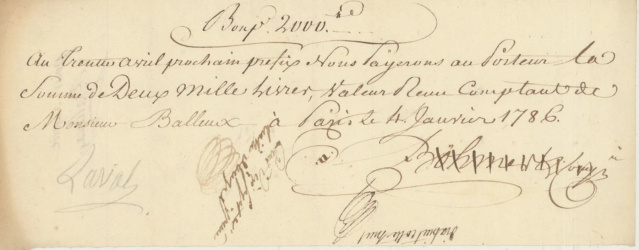|
| | L’Affaire du collier, un vrai scandale |  |
| | | Auteur | Message |
|---|
betagen

Nombre de messages : 275
Date d'inscription : 26/07/2016
 |  Sujet: L’Affaire du collier, un vrai scandale Sujet: L’Affaire du collier, un vrai scandale  Mar 8 Juin - 11:05 Mar 8 Juin - 11:05 | |
| Partie 1 et zou https://www.europe1.fr/emissions/Au-coeur-de-l-histoire/laffaire-du-collier-un-vrai-scandale-partie-1-4048726
Partie 2 et zou https://www.europe1.fr/emissions/Au-coeur-de-l-histoire/laffaire-du-collier-un-vrai-scandale-partie-2-4048729
_________________
Il court il court le furet
|
|   | | Little Po

Nombre de messages : 119
Date d'inscription : 15/04/2015
 |  Sujet: Re: L’Affaire du collier, un vrai scandale Sujet: Re: L’Affaire du collier, un vrai scandale  Sam 21 Jan - 13:03 Sam 21 Jan - 13:03 | |
| The Year of Marie Antoinette – The Affair of the Diamond Necklace - By the time of the Affair of the Diamond Necklace, Marie Antoinette’s popularity was already declining, and her reputation was tarnished by gossip.
The necklace in question was commissioned by King Louis XV of France, who was Marie Antoinette’s grandfather-in-law, in 1772, probably for his mistress, Madame du Barry. The necklace cost approximately 2 million lives and was made by jewellers Charles Auguste Boehmer and Paul Bassange. It consisted of 647 diamonds with a weight of 2800 carats. Unfortunately, it had taken the jewellers several years to make, and in the meantime, King Louis XV had died of smallpox, and Madame du Barry had been unceremoniously exiled from court. As a result, the necklace remained unpaid, at significant personal investment of the jewellers, and they were becoming desperate to sell it.
They offered it to Marie Antoinette, who reportedly replied that she “found her jewel cases rich enough” and that they “had more needs of ships than of diamonds.”1 Even a discount could not change the Queen’s mind.
On 12 July 1785, Marie Antoinette received a letter from Boehmer. He wrote, “Madame, We are at the summit of happiness to dare to think that the latest arrangements which have been proposed to us and to which we have submitted with zeal and respect, are a new proof of our submission and devotion to the orders of Your Majesty. We have real satisfaction in the thought that the most beautiful set of diamonds in the world will be at the service of the greatest and best of Queens.”2 Marie Antoinette thought he was soliciting yet another piece of jewellery but was also baffled by the letter. She was determined not to buy from him and burned the letter.
However, Boehmer was under the impression that he had sold the diamond necklace and the letter had, in fact, been dictated by Cardinal de Rohan. The Cardinal was the one who actually paid for the necklace as he was under the impression that the Queen wanted it but did not have the immediate funds to buy it. He also believed he would gain the Queen’s favour as she had hardly ever spoken to him. As time passed following the purchase, Cardinal de Rohan could not understand why Marie Antoinette did not wear the necklace. He even had notes with Marie Antoinette’s signature, which he used to stave off making his own payments on the necklace. Boehmer eventually went to see Madame Campan, who was in Marie Antoinette’s service, who told him that “the Queen had never seen his necklace and that he had been cheated.”3
As the truth unravelled, Cardinal de Rohan revealed that he believed to have been commissioned by the Queen as he had received a letter from her via the Comtesse de Lamotte Valois. Marie Antoinette was indignant and asked why he would believe that she would commission him – a man she had not spoken to for eight years and “especially through the mediation of such a woman?”4 The Comtesse was, in fact, a trickster, and she had signed the notes as “Marie Antoinette de France”, something Marie Antoinette never did. A courtier would have known this. The overwhelmed Cardinal agreed to write down his own account, but he remained as confused as before.
Marie Antoinette’s good name, as far as she still had one, was on the line, and her husband was desperate to preserve it. He said, “The name of the Queen is precious to me, and it has been compromised.”5 Although chivalrous, public opinion would not be so kind. Cardinal de Rohan opted to be tried by the Parliament de Paris, which prolonged the situation and turned it more political. He managed to have all his correspondence with the Comtesse burned before his arrest. Marie Antoinette’s hope that “we shall hear no more of this horrible business” would be crushed soon.6
The Comtesse had set up an elaborate plan with her husband and her lover to rob the Cardinal. She had forged the commission and the repayment plan. On 21 January 1785, the Comtesse claimed that Marie Antoinette wanted to buy the necklace.7 The jewellers were all too relieved to accept the lower price of 1,6 million francs. She picked out a young woman who resembled Marie Antoinette, who met with the Cardinal and who promised him that the past would be forgotten. Once the necklace itself was in their possession, it was taken to London, where the diamonds were pried out and sold. To this day, it is unclear where the stones ended up. Then the story began to unravel, and the Comtesse was arrested shortly after the Cardinal. Her lover soon suffered the same fate, but her husband remained at large.
The Cardinal and the Comtesse’s trial began in May 1786, and Marie Antoinette’s testimony was submitted in writing. On 31 May, the Cardinal was acquitted, although he had to seek King Louis XVI’s pardon and divest himself of all his offices. He was also banned from court. The Comtesse (and her husband in absentia) were sentenced to flogging, branding and life imprisonment. The Comtesse was stripped naked and beaten and then branded as a thief with the letter V for voleuse. She struggled so much against the branding that it missed her shoulder and ended up on her breast. She was then taken to the Salpêtrière prison, where she was to spend the rest of her life. She managed to escape the following year and spent several years in England attacking the Queen in memoirs. She died in 1791, having fallen or having been thrown from a window.8
https://www.historyofroyalwomen.com/the-year-of-marie-antoinette-2023/the-year-of-marie-antoinette-the-affair-of-the-diamond-necklace/
 Marie Antoinette wept upon hearing that the Cardinal had been acquitted. Although she had been entirely innocent in the affair, the damage to her reputation was irreparable. - Marie Antoinette by Antonia Fraser p.270
- Marie Antoinette by Antonia Fraser p.271
- Marie Antoinette by Antonia Fraser p.274
- Marie Antoinette by Antonia Fraser p.276
- Marie Antoinette by Antonia Fraser p.279
- Marie Antoinette by Antonia Fraser p.281
- How to ruin a Queen by Jonathan Beckman p.105
- Marie Antoinette by Joan Haslip p.164
Sad story.  
_________________
Avec elle je ne suis plus la reine, je suis moi
|
|   | | Chateaubriand

Nombre de messages : 104
Date d'inscription : 28/10/2022
 |  Sujet: Re: L’Affaire du collier, un vrai scandale Sujet: Re: L’Affaire du collier, un vrai scandale  Sam 25 Mar - 18:17 Sam 25 Mar - 18:17 | |
| Quittance des joailliers qui furent joailliers de la Cour, L.S. " Boehmer" et "Paul Basenge". Paris, le 4 janvier 1786 et le 10 Messidor an Douze,  https://www.giquelloetassocies.fr/ Encore des fournisseurs de la Cour qui ont bien réussi leur transition. |
|   | | Contenu sponsorisé
 |  Sujet: Re: L’Affaire du collier, un vrai scandale Sujet: Re: L’Affaire du collier, un vrai scandale  | |
| |
|   | | | | L’Affaire du collier, un vrai scandale |  |
|
Sujets similaires |  |
|
| | Permission de ce forum: | Vous ne pouvez pas répondre aux sujets dans ce forum
| |
| |
| |
